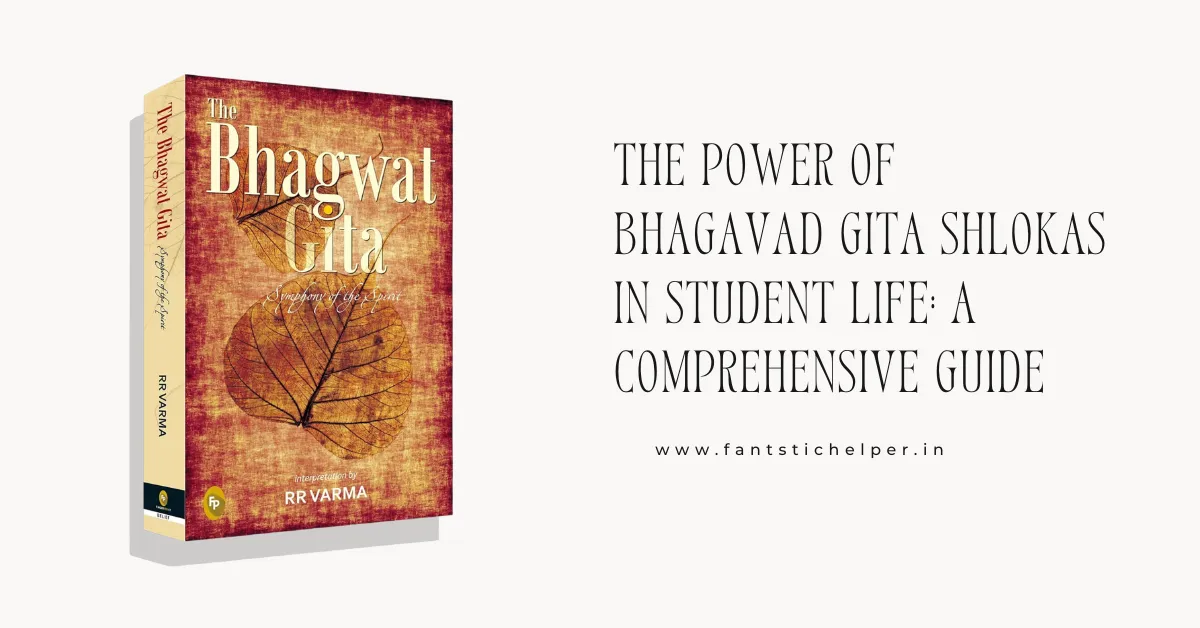| Name Of Article | Bhagavad Gita Shlokas for Student Life: A Comprehensive Guide |
Bhagavad Gita Shlokas in Student Life:
Bhagavad Gita Shlokas in Student Life
Are you a student looking for guidance, inspiration, and motivation in your academic journey? Look no further than the Bhagavad Gita! This ancient scripture is filled with powerful shlokas that can help you navigate the challenges of student life with wisdom and grace. In this comprehensive guide, we will explore how these timeless teachings can transform your mindset, enhance your focus, and lead you towards success. Join us on this enlightening journey as we uncover the power of Bhagavad Gita shlokas in shaping a fulfilling student life.
Bhagavad Gita Shlokas in Student Life
Introduction to the Bhagavad Gita and its relevance in modern times
The Bhagavad Gita, also known as the “Song of God,” is a timeless spiritual text that holds great significance and relevance in modern times. Believed to have been composed over 5000 years ago, it is a part of the epic Mahabharata and contains teachings from Lord Krishna to his disciple Arjuna on the battlefield of Kurukshetra.
Despite its ancient origins, the teachings and principles of the Bhagavad Gita are universal and can be applied to various aspects of our lives, including education. In this section, we will explore how this sacred scripture can guide students in their academic journey and help them lead a fulfilling life.
One of the main reasons for the enduring popularity and relevance of the Bhagavad Gita is its emphasis on self-realization and inner growth. It encourages individuals to look within themselves for answers rather than seeking external validation or relying on material possessions. This is particularly relevant in today’s fast-paced world where students are constantly bombarded with societal pressures and expectations.
The Bhagavad Gita teaches us about detachment from outcomes, which is crucial for students facing academic challenges such as exams or assignments. By focusing on putting in their best effort without worrying about results, students can reduce stress and anxiety levels and perform better academically.
Moreover, the concept of karma yoga (selfless action) taught in the Bhagavad Gita promotes an attitude of service towards others rather than being solely focused on personal achievements. This mindset can help students develop a sense of responsibility towards society while balancing their own goals.
Another significant aspect of the Bhagavad Gita is its teachings on managing emotions. The battle between good and evil depicted in this scripture symbolizes an individual’s internal struggle between positive thoughts (represented by Pandavas) and negative thoughts (represented by Kauravas). By understanding these emotions and learning to control them through practices like meditation, students can maintain a positive outlook and handle difficult situations with resilience.
Furthermore, the Bhagavad Gita emphasizes the importance of acquiring knowledge and wisdom. It encourages students to be curious, ask questions, and seek knowledge from their teachers and mentors. This approach to learning can help students develop critical thinking skills and broaden their perspective on various subjects.
The Bhagavad Gita offers timeless teachings that are relevant not only for spiritual growth but also for navigating modern-day challenges. By incorporating its principles into their student life, individuals can find inner peace, balance, and fulfillment while pursuing academic goals. In the following sections of this guide, we will delve deeper into specific shlokas from the Bhagavad Gita that hold immense power in shaping a student’s mindset and actions towards success.
Bhagavad Gita Shlokas in Student Life
Understanding the concept of shlokas and their significance in student life
The Bhagavad Gita, also known as the “Song of the Lord,” is a sacred Hindu text that contains teachings and guidance on how to live a fulfilling life. One of the most powerful components of this ancient scripture is its shlokas or verses. These shlokas are short, poetic phrases that are packed with deep wisdom and spiritual insights.
In student life, understanding and reciting these shlokas can bring immense benefits. They not only help in academic studies but also provide guidance for personal growth and development. Shlokas from the Bhagavad Gita touch upon various aspects of life, including discipline, focus, determination, resilience, and moral values.
Also Read : 10 Chanakya Niti Quotes Every Student Needs
One of the main reasons why shlokas hold such significance in student life is because they offer practical solutions to everyday challenges. As students navigate through their academic journey, they often face stress and pressure to perform well. The Bhagavad Gita shlokas act as a source of inspiration and motivation during these tough times. They remind students to stay focused on their goals while maintaining a calm mind.
Moreover, these verses also emphasize the importance of self-discipline in achieving success in any endeavor. Students who incorporate this principle into their daily lives are more likely to excel academically as well as personally. The famous verse “Karmanye Vadhikaraste Ma Phaleshu Kadachana” (Chapter 2 Verse 47) teaches us that we have control over our actions but not over the results. This means that rather than getting attached to outcomes, one should focus on putting in sincere efforts without expectations.
Another essential aspect highlighted by Bhagavad Gita shlokas is morality and ethical living. In today’s fast-paced world, where instant gratification has become the norm, it is crucial for students to understand the importance of moral values such as honesty, compassion, and respect towards others. Shlokas like “Ahimsa Paramo Dharma” (Chapter 17 Verse 14) remind students to uphold the principle of non-violence in their thoughts, words, and actions.
Furthermore, Bhagavad Gita shlokas also teach the concept of detachment and letting go of attachments. As students face constant pressure to meet societal expectations, these verses act as a reminder that true happiness lies in inner peace rather than external achievements.
Understanding the concept of shlokas from the Bhagavad Gita and incorporating them into one’s student life can have a profound impact. These verses provide valuable lessons on discipline, self-control, ethical living, and detachment – all essential qualities for a successful and fulfilling life. By reciting these shlokas with sincerity and applying their teachings in daily life, students can experience a positive transformation that will benefit them not only academically but also spiritually.
Bhagavad Gita Shlokas in Student Life
How incorporating shlokas from the Bhagavad Gita can benefit students
The Bhagavad Gita, one of the most revered spiritual texts in Hinduism, is not just a source of ancient wisdom and guidance for individuals seeking spiritual enlightenment. Its teachings and shlokas (verses) have also been found to hold great significance in modern-day education, especially for students. The incorporation of these shlokas in student life has been proven to have numerous benefits that can enhance their academic performance as well as overall personal growth.
One of the key benefits of incorporating shlokas from the Bhagavad Gita into a student’s daily routine is the cultivation of discipline and focus. The Gita emphasizes the importance of self-discipline and control over one’s senses, which are essential qualities for any student to succeed academically. By reciting or meditating on these shlokas regularly, students can train their minds to stay focused on their studies and resist distractions.
Moreover, the Bhagavad Gita teaches valuable lessons about managing stress and anxiety, which are common challenges faced by students. As they navigate through exams, assignments, and other academic pressures, students often find themselves overwhelmed with stress. However, with regular recitation or contemplation of shlokas such as “Karmanye Vadhikaraste Ma Phaleshu Kadachana” (do your duty without attachment to results), students can learn to detach themselves from outcomes and focus on putting in their best efforts without stressing over the results.
In addition to providing practical solutions for everyday challenges faced by students, incorporating shlokas from Bhagavad Gita can also have a positive impact on their moral development. The teachings of the Gita promote values like honesty, compassion, humility, and selflessness – all crucial qualities that shape an individual’s character. By understanding these concepts through recitation or interpretation of relevant shlokas like “Ahimsa Paramo Dharma” (non-violence is the highest duty), students can learn to embrace these values and apply them in their daily lives.
Furthermore, the Bhagavad Gita also offers insightful guidance on decision-making and problem-solving. The shlokas “Buddhiyukto Jahatiha Ubhe Sukrutadushkrite” (one who is attached to intelligence relinquishes both good and bad deeds) encourages individuals to think logically and make sound decisions without being influenced by emotions or external factors. This is especially relevant for students facing difficult choices during their academic journey.
Incorporating shlokas from the Bhagavad Gita into student life can bring a multitude of benefits that go beyond just academic success. From instilling discipline and focus to promoting moral values and shaping character, the power of these ancient verses has been proven time and again. By embracing the teachings of the Gita, students can not only excel in their studies but also lead a fulfilling and meaningful life.
Top 5 shlokas from the Bhagavad Gita for students with their meanings and explanations
The Bhagavad Gita is an ancient Hindu scripture that holds immense wisdom and guidance for all aspects of life, including education. Its shlokas (verses) are a source of inspiration and motivation for students to navigate through the challenges of academic and personal growth. In this section, we will explore the top 5 shlokas from the Bhagavad Gita that can empower and guide students in their journey.
1. “Karmanye Vadhikaraste Ma Phaleshu Kadachana” – Chapter 2, Verse 47
Meaning: This verse translates to “You have the right to work but never to its fruits.” It emphasizes on focusing on one’s actions rather than worrying about the outcomes. As students, it is essential to give our best effort without getting too attached to the results. This shloka teaches us detachment from success or failure and encourages us to focus on our present actions with sincerity and dedication.
Explanation: As students, we often get overwhelmed by expectations and outcomes set by ourselves or others. However, this shloka reminds us that our duty is only towards putting in our best efforts without any thoughts of rewards or consequences. It teaches us to be detached from external factors and instead concentrate on doing our work with integrity.
2. “Uddhared Atmana Atmanam Na Atmaanam Avasadayet” – Chapter 6, Verse 5
Meaning: This verse means “Elevate yourself by yourself; do not degrade yourself.” It emphasizes on self-motivation and self-improvement rather than seeking validation or approval from others.The true measure of success lies in constantly striving towards self-growth rather than comparing oneself with others.
Explanation: The modern education system often fosters competition among students, which can lead to feelings of self-doubt or inadequacy if one does not meet societal standards of success. This shloka teaches us that our worth is not defined by external validation, but by our own efforts and progress. It inspires students to focus on their individual journey of self-improvement rather than comparing themselves with others.
3.”Matra Sparshas Tu Kaunteya Sitosna Sukha Dukhda” – Chapter 2, Verse 14
Meaning: This verse translates to “O son of Kunti, the pleasures and pains that come through contact with the senses are temporary and fleeting.” It reminds us that the ups and downs in life are inevitable, and we must learn to detach ourselves from them.
Explanation: As students, we tend to get carried away by momentary pleasures or sorrows like receiving praise or facing failure. However, this shloka teaches us to not let these experiences affect us deeply as they are temporary. Instead, we should focus on our long-term goals and remain steadfast in our efforts even during challenging times.
4.”Yada samharate cayam kurmo ‘ngani vasar Tada nai’vam papam, cahanubhuya vyate punah maranam, sakyam uptum varna i’vam.” – Chapter 2, Verse 22
Meaning: “As a person puts on new garments, giving up old ones, similarly, the soul accepts new material bodies, giving up the old and useless ones.”
Explanation: This verse uses the metaphor of changing clothes to illustrate the cycle of birth and death. Just as a person discards old clothes and puts on new ones, the soul discards its old body at death and takes on a new one in the process of reincarnation. The verse emphasizes the impermanence of the physical body and the eternal nature of the soul. It suggests that just as we change clothes according to circumstances, the soul undergoes changes in bodies according to its past actions (karma) and desires, until it achieves liberation (moksha). This concept underscores the importance of understanding the transient nature of material existence and focusing on spiritual growth to attain liberation from the cycle of birth and death.
5.”buddhiyukto jahatiha ubhe sukrutadushkrute tasmad yogaya yujyasva yogah karmasu kaushalam” Chapter 2, Verse 50
Meaning: “A person endowed with wisdom casts off here both good and bad deeds; therefore, strive for yoga (skillfulness) in action. Yoga is skill in action.”
Explanation: This verse highlights the significance of developing wisdom and discernment in decision-making. It suggests that a person with a cultivated intellect transcends the attachment to both good and bad deeds, focusing instead on skillful action. For students, this shloka emphasizes the importance of making informed choices and acting with skillfulness in their academic, personal, and professional endeavors.
Also Read : Chanakya Motivational Thoughts For Students in Hindi
Tips on how to incorporate shlokas into daily student life
The Bhagavad Gita is a timeless spiritual text that contains valuable teachings and insights on how to live a fulfilling life. For students, incorporating shlokas (verses) from the Bhagavad Gita into their daily routine can be immensely beneficial in navigating the challenges of academic life. In this section, we will discuss some tips on how to seamlessly incorporate shlokas into your daily student life.
1. Start Your Day with Shlokas: The first thing you do in the morning sets the tone for the rest of your day. Begin your day by reciting a few shlokas from the Bhagavad Gita. This will help you set your intentions for the day and bring a sense of calmness and positivity.
2. Create an Altar or Shrine: Setting up a small altar or shrine in your room dedicated to the Bhagavad Gita can serve as a reminder to incorporate its teachings into your daily life. You can keep a copy of the book, along with other items such as candles, incense, and flowers on this altar.
3. Chant During Study Breaks: When taking breaks from studying, instead of scrolling through social media or checking emails, take a few minutes to chant shlokas from the Bhagavad Gita. This will not only give your mind and eyes some much-needed rest but also provide mental clarity and focus when you return to studying.
4. Use Shloka Cards: There are various decks available that contain selected shlokas from the Bhagavad Gita along with their meanings. These cards can be carried around easily and serve as gentle reminders throughout the day to stay grounded and focused.
5. Incorporate Shlokas into Your Study Routine: While studying, take short breaks between subjects or topics and recite shlokas related to knowledge or learning from the Bhagavad Gita. This practice can help you stay connected to your spiritual self while also enhancing your understanding and retention of the subject matter.
6. Practice Gratitude: The Bhagavad Gita emphasizes the importance of being grateful for what we have. Take a moment before going to bed to reflect on your day and express gratitude for all the blessings in your life. This practice can help cultivate a positive mindset and reduce stress levels.
Incorporating shlokas from the Bhagavad Gita into daily student life can bring numerous benefits such as increased focus, mental clarity, and overall well-being. By following these tips, you can seamlessly integrate these powerful verses into your routine and experience their transformative power in your academic journey.
Bhagavad Gita Shlokas in Student Life
Real-life examples of students who have benefited from practicing shlokas
The Bhagavad Gita is a timeless spiritual text that has been guiding people for centuries. Its teachings are not limited to any particular age or profession, and students can especially benefit from its wisdom. The practice of reciting shlokas from the Bhagavad Gita has been proven to have a positive impact on students’ lives, both academically and personally. In this section, we will explore some real-life examples of students who have experienced the transformative power of practicing shlokas.
1) Rohit Sharma:
Rohit Sharma was an engineering student struggling to cope with the pressure of his studies. He often felt overwhelmed and anxious about exams and coursework. However, after being introduced to the Bhagavad Gita by his mother, he started incorporating shloka recitation into his daily routine. He found that it helped him calm his mind and stay focused during study sessions. Rohit also noticed that he was able to retain information better and perform well in exams after regularly chanting shlokas from the Bhagavad Gita.
2) Tanvi Mehta:
Tanvi Mehta was a high school student who used to feel stressed out due to her busy schedule of academics, extracurricular activities, and social commitments. She struggled with time management and often felt overwhelmed by her workload. Upon learning about the power of shloka recitation in managing stress, Tanvi decided to give it a try.
She started waking up early every morning and dedicating 15 minutes towards chanting shlokas before starting her day. Gradually, she saw a significant improvement in her time management skills as well as overall mental well-being. Tanvi felt more focused, energized, and at peace throughout the day.
3) Aarav Patel:
Aarav Patel was an MBA student who had lost interest in his studies due to personal issues affecting him emotionally. His lack of motivation was affecting his academic performance and causing him to fall behind in class. However, a chance encounter with a guru who introduced him to the Bhagavad Gita changed Aarav’s life.
He started practicing shlokas from the Gita every day and found solace in its teachings. The shlokas helped him overcome his emotional struggles and rekindled his passion for learning. Aarav not only caught up with his studies but also excelled in them, thanks to the inner strength he gained through chanting shlokas.
These are just a few examples of students who have experienced the positive impact of incorporating shloka recitation into their lives. Regular practice of these powerful verses can help students develop focus, clarity, self-discipline, and mental resilience – qualities that are crucial for success in academics as well as personal growth. So if you’re a student looking to enhance your overall well-being and reach your full potential, consider adding shloka recitation to your daily routine.








